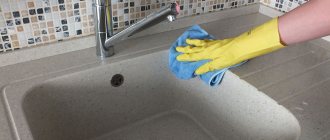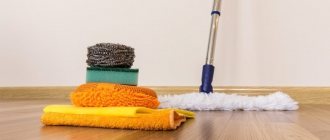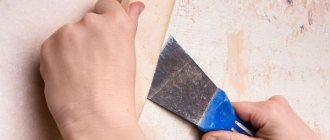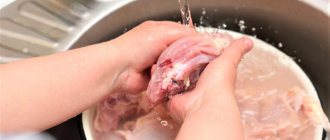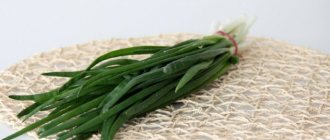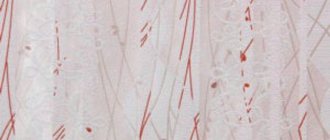The modern market offers a huge selection of wall coverings, among which wallpaper occupies a special place. There are many types of them, and it is very important to properly care for such a finish, regardless of whether it is moisture resistant or not.
Let's take a closer look at whether non-woven wallpaper and other types of these materials can be washed, and whether cleaning will spoil their surface.
How to wash non-woven vinyl wallpaper
These coatings have many advantages compared to paper and some others. They are not only easy to glue, but can also be washed and painted several times. But not everyone knows how to properly wash non-woven wallpaper so as not to damage its texture and pattern.
Folk remedies
Citric acid is used to clean this coating. For this you need 3 tbsp. Dilute spoons of powder in 200 ml of water (warm), moisten a soft cloth with the solution and apply it to the wall. Wait 3-5 minutes, repeat the procedure to remove dirt and dry the surface.
Purchased funds
Let's consider the general algorithm of actions when cleaning walls using household chemicals.
Required:
- cloth or sponge;
- water in a basin or other container;
- detergent (for example, dishwashing detergent or any other preparation).
The wallpaper cleaning process is quick and easy. To work, you just need to prepare the necessary materials.
Important: do not dry washable wallpaper with a hairdryer or by airing. This will not only not speed up the drying process, but can also ruin the wall coating.
- Prepare a solution of detergent and water in a ratio of 1 tsp. per liter respectively.
- Dip a sponge or cloth into the resulting mixture and squeeze it out.
- Clean the wallpaper from top to bottom.
- Wipe the washed areas with a dry sponge, cloth or brush and leave to dry.
Why does wallpaper get dirty?
Despite its practicality, vinyl wallpaper gets dirty over time.
Vinyl is a foam material fixed with inbrids that is soft and pleasant to the touch. This finish is durable and practical, suitable for renovation in rooms with high humidity. If you wish, you can update the interior and change the color of the walls by painting. Sometimes it is enough to simply wash them to restore freshness and remove dirt that appears in the most visible areas.
The most common reasons why wallpaper gets dirty:
- Seam wear . At the joints, several years after gluing, the edges lose their plasticity, the seams separate, bend, and dust and dirt get clogged there.
- Porous structure . The surface of the wallpaper is uneven, so dust microparticles gradually accumulate in the pores, which is why the canvas takes on an earthy color.
- Food stains . Appear as a result of careless handling of food and drinks.
- Hand marks . Walking around the room, household members touch the walls and stain them.
Pollution can also be caused by children's pastimes - kids paint the walls with felt-tip pens, pencils or “unloved porridge”. These stains are difficult to clean without damaging the finish.
How to wash paper-based vinyl wallpaper
Let's consider whether wallpaper with a paper base can be washed.
Folk remedies
Such coatings can be easily cleaned with laundry soap. To do this, just prepare a solution. It should be done in a ratio of 1:10 in relation to detergent to water. You need to carefully apply the composition to the wall using a rag, then you need to rinse it, wring it out and remove any remaining soap from the treated area.
Purchased funds
Paper-based vinyl wallpaper can only be wiped with a damp cloth and detergent. If the contamination is strong, it is allowed to wash the coverings, but do it very quickly, in the same way as non-woven ones.
Choosing washable wallpaper for the kitchen
If you go into a hardware store or a specialty wallpaper store, you may leave without buying anything. The explanation is simple - there is so much choice that the buyer’s eyes are wide open and the buyer can no longer adjust the rolls to his kitchen. For a good purchase, washable vinyl wallpaper for the kitchen should meet the following recommendations:
- You should not choose canvases with patterns and designs that do not visually suit your kitchen. You need to choose based on the furniture and the size of the room. Some colors create the illusion of a smaller area, others do the opposite. Therefore, watch this carefully;
- choose shades of the same color scheme. Don't try to combine different color structures. In the end it won't look nice. If your window faces the sun, it's best to go for a color that blends with the sun's rays;
- There are a lot of wallpapers that depict simple drawings of food or kitchen utensils. This option is good if the kitchen for you is a regular place where you just prepare food. Otherwise, if this room has a special style, avoid such canvases;
- If your furniture is made of wood in a rustic style, a good solution would be to purchase “brick” or “stone” wallpaper. This choice will make vinyl washable wallpaper for the kitchen without adjusting possible. Because the rolls can be glued from any side, which means that it is not necessary to observe the fit as carefully as in other cases.
How to remove grease from washable trim
Grease stains, splashes, and fingerprints can be washed off in several ways. To do this you will need readily available materials.
Important: any wallpaper must be washed very quickly so that it does not get damaged or come off the wall.
Grease stains appear more often in the kitchen. They are most easily removed with baby powder. This is done as follows:
- Sprinkle a sponge or rag with talcum powder.
- They wipe the wall. Leave for 10 minutes.
- Remove the powder with a dry cloth.
There is another way to remove grease stains. It involves using an iron and paper towel.
- Place a napkin over the stained area.
- Carefully iron this area with an iron.
Traditional methods for removing stains from wallpaper
Washing off dirt with improvised means that every housewife has at home allows you to get a decent result and does not require additional costs.
Cleaning from dirt
The most popular methods:
- Prepare an aqueous solution of baking soda at the rate of 20 g of soda per 1 liter of water. Use a sponge soaked in liquid (should not run off, squeeze out excess) to wash away dirt from the wallpaper. Then wipe the treated surface with a cotton rag soaked in plain water.
- Prepare a soap solution. Proceed as in the previous case.
A soap or soda solution is a universal remedy that allows you to get rid of dust and general dirt. For stubborn stains, try other cleaning options.
After wallpapering, traces of glue usually remain at the joints.
Getting rid of some types of adhesives is problematic, but the following advice sometimes allows you to get a good result:
- Soak a cotton pad in 95% vinegar.
- Wipe the area with any remaining glue.
- After 10 minutes, remove vinegar stains with a wet cloth.
Removing greasy stains
Grease stains on the walls in the kitchen are quite common.
You can get rid of them this way:
- Using talc. Pour talc onto a sponge, rub the greasy stain, leave for 10 minutes. Remove any remaining talc.
- Using paper. Place a clean sheet of white paper on the stain. Iron the sheet with a warm, but not hot, iron until the paper has absorbed all the fat. Change paper whenever it gets dirty.
After removing the stain, wipe the surface with a damp cloth.
Pen marks
The ink is difficult to remove, but the following methods will give you a satisfactory result:
- Dilute potassium permanganate in 5% vinegar to achieve a rich crimson color. Soak a cotton pad in the resulting solution and wash off the ink mark. To remove fine lines, brushes should be used. Before drying, wash the resulting stains with a cloth soaked in hydrogen peroxide.
- Add 20 g of citric acid to half a glass of water and stir. Treat ink stains in the same way.
- Buy a melamine sponge. Erase the ink using the sponge as an eraser.
Be sure to read:
How to clean tiles from old mortar, cement and use them again
Regular pen erasers also allow you to make the pen mark almost invisible.
Plasticine
Sequencing:
- Carefully cut off the “extra” plasticine with a knife.
- Using a running hair dryer, heat the remaining plasticine and remove it with a napkin or toilet paper. As a result, a greasy stain remains.
- Soak a cloth in a concentrated solution of laundry soap and use a circular motion to wash off the stain.
- If necessary, go over the problem area again with a clean, wet cloth.
You can evaluate the result after the walls have completely dried.
Blood stains
There are several options:
- Suitable for moisture-resistant wallpaper. Use a wet cloth to soak the blood stain and wipe it away.
- Apply a few drops of hydrogen peroxide to a cotton pad. Apply it to the stain, the peroxide dissolves the blood, and it is absorbed into the cotton wool.
The second method is more acceptable for wallpaper that is not very durable.
Removing brilliant green
Known methods:
- Moisten the stain with water, cover with a thin layer of baking soda, add a drop of 5% vinegar. Rub lightly with a damp cloth to remove any remaining components.
- Add a little water to the starch and stir. Apply the resulting mixture to the green stain. Wait until the mixture dries completely. The green stuff should be absorbed into the starch. Wipe off any remaining product with a dry cloth.
- The method is suitable for light-colored canvases. Moisten a cotton pad with hydrogen peroxide or alcohol and wipe the stain with it. After an hour, remove the stain with a damp cloth.
How to clean markers and ink from walls
If such “art” decorates your room, don’t be upset. These stains can be washed out from wallpaper that is not silkscreen or paper.
In addition, pay attention to the type of markers: if they are alcohol-based, the drawing can be easily erased with alcohol or vinegar, rubbing the liquid into the stain with a cotton pad. It is much easier with water-based markers; they are washed off with plain soapy water.
Fingerprints can be removed using an eraser. To do this, just rub the stain with a little force.
Caring for wallpaper after washing
Wallpaper does not require frequent cleaning. Even if they are washable, you shouldn't wash them regularly. This is done as soon as it becomes dirty or visible stains form. After completing such cleaning, the wallpaper must be dried thoroughly. It is better to do this in a ventilated area to prevent mold. But there is no need to use a hairdryer for drying, which can cause the canvas to peel off.
It is important when purchasing wallpaper to take into account the characteristics of the room in which it will be glued.
How to wash before painting
If the wallpaper is to be painted, it must first be degreased and free of dust.
You can simply use a vacuum cleaner or steam cleaner for light cleaning, but if the dirt is more serious than dust, you need to wash the wallpaper. This is done as follows:
- We wipe the wall covering with a cloth or sponge soaked in soapy water.
- We wipe the area with a dry cloth or soft washcloth.
- Let the wall dry. You need to let it dry completely, but without a hairdryer or draft. After this, it will be possible to produce high-quality painting.
Wallpaper structure
If the question arises of how to wash vinyl wallpaper, then you should first understand the structure of the material. They are manufactured using a special technology that can withstand heavy loads. Most often they are called two-layer. In this case, the second layer can be different:
- paper;
- non-woven
If you have a paper base, it will not withstand moisture. This is worth considering from the very beginning. Yes, manufacturers may label that they can also be wiped with a damp cloth, but it is better to do this very carefully. Although the top layer is largely responsible for moisture protection, water getting on the paper inevitably leads to deformation of the material.
The non-woven base is more resistant to deformation. Therefore, buyers are now increasingly choosing these options. Yes, their cost will be slightly higher. But they also have much better quality.
How to make your own hand wash
In addition to detergent and soap, baking soda is great for cleaning wall coverings. This solution can be prepared at home and from scrap materials. This folk method is based on soda.
What is needed for the solution
- soda - 40 g;
- warm water - 2 l.
How to clean a wall with baking soda
- Combine the powder with water. Mix thoroughly until smooth.
- Dip the sponge into the solution and carefully wipe the wall with it.
Important: baking soda will help get rid of not only dirt and grease, but also unpleasant odors. With special effort, you can even wipe away soot, plaque, and mold.
Stain removers
| Types of pollution | What to wash with? |
| Fat | Rub talcum powder or chalk into the stain, then clean with a rag; Use an iron to iron the stained area through a napkin or paper; Apply a cotton wool moistened with gasoline to the stain for several minutes. |
| Ballpoint pen and ink | You can clean it with a solution of potassium permanganate and vinegar, a solution of detergent and water, a melamine sponge, or rinse with half a lemon. |
| Felt pen | Clean the stained area with hydrogen peroxide, lemon juice or medical alcohol using a cotton swab. |
| Colour pencils | Rub with an eraser or toothbrush with washing powder. Gently wipe with solvent (vinyl wallpaper). Suitable for light surfaces. |
| Wax pencil and crayons | Dilute floor cleaner in water, rinse the surface and allow to dry. Or rub it with an eraser. |
| Fingerprints | Clean with an eraser, soda or talcum powder. Wash with soapy water. |
| Dye | Clean the stained area with acetone without touching the clean part of the wallpaper. You can try scraping off the dried paint. |
| Glue | Moisten a cloth with water and rinse the area of contamination using circular movements. |
| Plasticine | Gently scrape off with a knife and heat with a hairdryer, then clean the area with a slightly damp cloth. |
| Mold | Clean with a solution of baking soda in water, rinse with hydrogen peroxide. |
| Tobacco removal | Yellowness is difficult to remove. You can treat it with a vinegar solution and rub it with lemon juice. |
| Soot | To begin with, the walls can be cleaned with a vacuum cleaner. Then use a dry cleaning sponge, washing liquid or solvent. Paper wallpaper cannot be cleaned without damage; it is better to remove the old ones and stick on fresh ones. |
| Zelenka | Rinse with a solution of lemon juice, alcohol and water. Clean with hydrogen peroxide. |
| Pomade | Wash with soapy water or foam detergent. |
| Wine | Fresh stains can be washed with soapy water. An old stain is almost impossible to clean. |
With proper regular care, you can extend the life of your wallpaper and maintain the brightness of the colors. A little trick and a product that you almost always have on hand will help you get rid of unexpected stains and wash away dirt. It is important to remember that each type of wallpaper has a different composition and interacts with water differently; in order to avoid troubles, you need to take into account the instructions on the label.
What to do if there is no marking
There are special signs on the wallpaper. They show how the coating reacts to water and other external factors. For example, a marking with one wave means that the material can only be wiped with a damp cloth, with two such icons - you can use some detergents, with three - the wallpaper is very resistant to water and can be safely washed. And the sign with waves and a brush means that you can use a washing vacuum cleaner and other cleaning products.
But how do you know if non-woven vinyl wallpaper can be washed if there is no marking? If there are no signs, just check the reaction of the wallpaper to moisture in an inconspicuous place. To do this, just select a small corner of the coating and wash it in one of the following ways: if it is not damaged, you can continue working with the entire wall.
We looked at the main ways to properly wash wallpaper. This task is not so difficult if you follow all the recommendations in the article and video, and also avoid heavy contamination. You can use both purchased products and traditional cleaning methods for this procedure - your walls with a stylish coating will retain their fresh, original appearance for a long time!
General tips and tricks
- Before washing, you need to understand the type of wallpaper. To do this, you need to look at the markings and then choose the best option.
- Even the most wear-resistant material will not withstand brute force; there is no need to scrub with a hard brush or use too much water.
- Before you begin removing stains, it is worth doing a test cleaning in the least visible place to make sure that the chosen method is correct.
Advantages and disadvantages
Such wallpaper is relatively new on the market, but this time was enough to appreciate all the advantages of non-woven wallpaper:
- maintaining dimensions after drying;
- increased density of the canvas, allowing you to hide cracks and unevenness on the wall;
- resistance to fire, smoldering and high temperatures;
- oxygen transmission;
- water resistance;
- maintainability;
- possibility of painting.
Separately, it should be noted such features of non-woven wallpaper as ease of gluing and leveling. When using non-woven wallpaper, glue must be applied only to the wall. This helps preserve the quality of the flooring, time and effort spent on repairs. Wallpaper can also be removed easily. Before removing non-woven wallpaper, you do not need to carry out any preparatory measures.
Non-woven wallpaper also has disadvantages:
- low resistance to dirt due to the porous structure and ability to collect dust;
- high cost relative to other types of wallpaper.
It is worth noting that these disadvantages are very insignificant relative to the advantages, which makes any non-woven wallpaper the most popular material for interior decoration. And if you know how to glue meter-long non-woven wallpaper, then soon the room will sparkle with new colors.
How to clean dirt from wallpaper
If you've ever had a question about how to remove dirt from wallpaper, you'll find the answer here. The article discusses both household chemicals and folk remedies such as baking soda or citric acid. We tell you what type of wallpaper can be cleaned with what product and how to do regular cleaning so as to keep the wallpaper looking fresh for as long as possible.
Before you start cleaning your wallpaper, find out what type it is. On the roll packaging or in the insert, the manufacturer provides information about the material and recommended care methods. If you don't have them, you'll have to experiment on a small, inconspicuous area of the coating.
Pros and cons of the material
Non-woven wallpaper is intended for wall decoration. Consist of non-woven backing and foam vinyl. Non-woven fabrics have a thin paper base, which is covered with a layer of PVC film on top. The finishing material contained in compact vinyl film is not afraid of moisture and cleaning devices, be it a hard brush or a damp sponge. Foamed vinyl film is resistant to cleaning with a damp cloth soaked in a solution of detergents.
Among the advantages of the material the following are noted:
- recognized as environmentally friendly;
- it has high elasticity and strength;
- has the ability to hide wall defects;
- can be painted;
- affordable price;
- practicality in operation.
Among the shortcomings are noted:
- the high cost of some wallpaper modifications;
- non-woven fabrics without additional composition are very thin, and therefore with the slightest defect they become unusable;
- a thin canvas can show through the previous paint color.
Wet cleaning and washing
First you need to understand what exactly is meant when people say that they are going to wash the wallpaper. Usually we are not talking about a full wash. If you really “wash” wallpaper, like people wash, for example, floors, then even the highest quality and reliable wallpaper will not be able to withstand it properly. The following problems will occur:
- the coating may warp;
- moisture can get under the wallpaper and cause the coating to peel off a little;
- the wallpaper pattern may be slightly damaged;
- Due to the abundance of moisture, mold may occur.
Therefore, you should not wash any wallpaper too much, no matter what it is. And another thing is that if the usual wet cleaning of the room is carried out, then it can also apply to the wallpaper, but we are talking specifically about wiping with a damp cloth, and not about wetting the surface of the walls with liters of water.
How to clean wallpaper using an eraser or melamine sponge
A regular stationery eraser is suitable for processing paper, non-woven or vinyl wallpaper.
Hand stains can be easily rubbed with an eraser.
If you put an eraser in a container of kerosene overnight, it will remove traces of pens and wax crayons.
A modern replacement for an eraser is a melamine sponge. Important! Melamine sponge is an abrasive material. It will perfectly clean vinyl wallpaper, but can damage the pattern on non-woven wallpaper. First you should test it on a small area.



